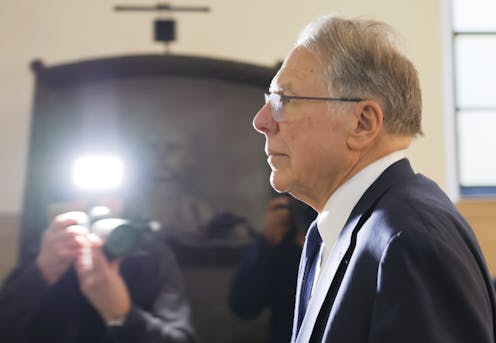
Wayne LaPierre, the National Rifle Association’s longtime leader, plans to retire by the end of January 2024. He cited “health reasons” when he announced his departure three days before the organization’s civil fraud trial got underway in Manhattan.
New York authorities have accused the NRA, LaPierre and three of his current or former colleagues of squandering millions of dollars the gun group had obtained from its members.
As a nonprofit accounting scholar who has followed the NRA’s finances for years, I believe the organization is not only at a legal crossroads but also at a financial one.
NRA business model
To see why the NRA finds itself in this difficult spot, it helps to first see how its business model allows for only a small margin of error. Despite the nonprofit’s long history– it was founded in 1871 by Civil War veterans who fought for the Union – the NRA has never had enough money stowed away to inoculate it from financial problems.
Consider the NRA’s circumstances in terms of its unrestricted net assets, which reflect the money an organization has available to spend after accounting for its commitments to donors.
Comparing this with the scale of an organization’s annual budget can provide a sense of how much of a rainy day fund is on hand.
In 2015, the NRA had unrestricted net assets that constituted just 9% of its total expenses. In contrast, that same year, the AARP, another long-standing social welfare organization with millions of members, had unrestricted net assets that amounted to 87% of its expenses.
In other words, the NRA’s coffers reflected a circumstance more in line with an employee living paycheck to paycheck than an heir living off a trust fund. For this reason, the NRA has always relied on its members’ annual dues to cover its costs, and it is less able to weather financial storms that can last years.
The controversies over the NRA’s spending and the organization’s political entanglements that have swirled around since 2016 constitute that kind of turbulence.
Declining financial fortunes
Following its substantial spending spree during the 2016 election cycle, the NRA found itself needing to dig out of a hole, with a budget deficit of more than US$40 million.
Subsequent years saw fluctuations in spending along with ongoing challenges to generate sufficient revenues to keep up with spending.
In recent years, the organization’s approach to its budget shortfall has been to cut costs, or at least some of its costs.
Spending on programming went from nearly $176 million in 2017 to just $73 million in 2022, its most recent reporting year.
Its traditionally core programs have taken the biggest hit: Spending on education and training fell from $7.7 million to $3.2 million; law enforcement support dropped from $3.8 million to $1.8 million; recreational shooting slipped from $7.2 million to $5.1 million; and field services declined from $11.9 million to $1.3 million.
Back in the red
The NRA hasn’t cut all of its spending, however.
During the same time frame, the NRA’s budget for administrative legal costs ballooned, from $4 million in 2017 to over $40 million in each of the past three reporting years, with this amount hitting $43.7 million in 2022.
The organization’s shrinking programming budget helped eliminate its deficit, at least for a time.
Thanks to its reduced spending, the NRA was able to finish the year with a surplus in both 2020 and 2021. However, that surplus, which came from slashing costs – particularly those geared toward core programs for members – proved short-lived.
The organization has also seen the ranks of its members dwindle. Fewer members mean less revenue from dues. In 2022, revenues were down by more than $100 million from their 2017 levels, a drop of more than one-third.
The declining revenues meant that, despite its trimmed-down budget, the NRA was back in the red in 2022 and again facing a negative unrestricted balance in net assets.
What’s next?
The NRA, in short, is in a financial spiral. Its shrinking budget has begotten a shrinking member base, leading to an even smaller budget. It may be hard to stem.
The organization has pared what it spends on its programs to the bone.
While there are no easy answers for what the organization can do about its financial predicament, it’s not the only pressing question the organization faces.
How long will the NRA’s remaining members stay loyal to it? When will high legal costs subside enough to ease the budgetary pressures? What does a smaller NRA mean for its ability to flex its political muscle?
Despite its many challenges, the NRA’s imminent changing of the guard does offer an opportunity to make more drastic shifts in its priorities, spending approaches and the pitches it makes to members and donors.
Further, with its large legal budget being the last remaining area ripe for cost cutting, perhaps the NRA’s next generation of leaders will set the stage for the organization to rid itself of its oversized legal burdens and refocus on core programs.
What is clear, however, is that financial constraints will dictate much of whatever course the new leadership seeks to chart.
Earlier versions of these charts ran in a related article on March 23, 2023.
Brian Mittendorf does not work for, consult, own shares in or receive funding from any company or organisation that would benefit from this article, and has disclosed no relevant affiliations beyond their academic appointment.
This article was originally published on The Conversation. Read the original article.







